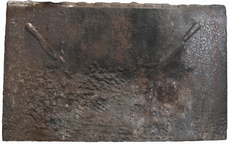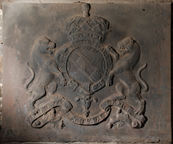-
1214
Description: Rectangular shape; no edging; shield of the 2nd Duke of Montagu surrounded by the Garter and surmounted by a ducal coronet.
Notes: One of four firebacks at Boughton House, Northamptonshire, cast with the ducal arms and the Garter having a diameter of 77cm. Fifty firebacks were cast for the house between 1743 and 1748 by Richard Ford, probably at Newland Furnace, but also possibly at Nibthwaite furnace, both then in north Lancashire. The arms are blazoned: Quarterly, 1st & 4th: Argent, three fusils conjoined in fess gules, a bordure sable (Montagu); 2nd & 3rd: Or an eagle displayed vert beaked and membered gules (Monthermer); on an escutcheon of pretence, Sable a lion rampant Argent a canton Argent charged with a cross Gules (Churchill); John, 2nd Duke of Montagu married Mary, daughter and co-heiress of John, 1st Duke of Marlborough.
Copies of this fireback are known.
Inscription: HONI.SOIT.QUI.MAL.Y.PENSE
Arms: Montagu quartering Monthermer with Churchill in an escutcheon of pretence - John Montagu, 2nd Duke of Montagu, KG
- Decoration tags:
- rectangular (shape)
- none (edging)
- carved pattern panels
- heraldic
- armorial
- text
Manufactured: in the mid-18th century probably at Newland Furnace in the Furness area of England.
Current location: Boughton House, Geddington, Northamptonshire, England.
- Attached to series:
- Personal armorial firebacks
- Montagu arms series
-
343
Description: Arched rectangular shape; no edging; initials evenly spaced around arch; date split between top corners.
Inscription: W S / 18 24
- Decoration tags:
- rectangular with round arch (shape)
- none (edging)
- individual letters
- individual numbers
- text
Manufactured: in 1824 in England.
Current location: Ightham Mote, Ightham, Kent, England.
Museum number: 825375 (part of the National Trust museum group)
- Attached to series:
- Date & initials firebacks
-
355
Description: Rectangular joined to pediment by symmetrical scrolls; fillet edging with embattling inside; shield, helm, crest, supporters and mantling of the city of Bristol; date split by bottom of shield; inscription in an oval cartouche below shield.
Notes: Both '3's in the date are a substitution, with another casting suggesting an original date of 1614 or 1624. The pattern-maker was also responsible for carving royal coats of arms in three West Country churches and a small number of series of firebacks in the first quarter of the 17th century. A variant with side extension panels is no. 952.
Copies of this fireback are known.
Inscription: 16 33 / [ARMES] BRISTOLL
Arms: City of Bristol
- Decoration tags:
- rectangular with detached pediment (shape)
- fillet (edging)
- whole carved pattern
- individual numbers
- armorial
- text
Manufactured: in 1633 possibly in the Forest of Dean area of England.
Current location: Kenilworth Castle, Kenilworth, Warwickshire, England.
Museum number: 88278827 (part of the English Heritage museum group)
- Attached to series:
- Civic firebacks
- Bristol armorial group
-
365
Description: Arched rectangular shape; astragal edging with parallel astragal enclosing a border of undulating convolvulus vine, leaves and flowers; bead and disc circle in arch, above a pair of lions rampant facing each other, between which are a five-pointed star above a rose.
Notes: A fireback in a retro-Regency style. Sotheby's auction, 27 Oct 2010, lot 209 (£2,500)
Copies of this fireback are known.
- Decoration tags:
- rectangular with round arch (shape)
- astragal (edging)
- whole carved pattern
- heraldic
- animals
Manufactured: in the late-19th to early-20th century in England.
Current location: in private hands, Lambourn, Berkshire, England.
- Attached to series:
- Miscellaneous pattern firebacks
-
1191
Description: Rectangular; twisted rope edging (top and sides only); eight shields of Ayloffe impaling Sulyard in three rows, 3-2-3; Ayloffe: sable, a lion rampant Or, collared gules, between three crosses formy of the second; Sulyard: argent, a chevron gules between three pheons inverted sable.
Notes: William Ayloffe (c1535-1584) of Bretons, Hornchurch, Essex, Justice of the Court of Queen’s Bench, married (c1560) Jane, dau. of Sir Eustace Sulyard, of Runwell, Essex. Illustrated in Lloyd (1925).
Arms: Ayloffe impaling Sulyard (William Ayloffe of Bretons, Hornchurch)
- Decoration tags:
- rectangular (shape)
- rope (edging)
- carved stamps
- heraldic
- armorial
Manufactured: in the early-17th century in the Weald area of England.
Current location: Great Dixter, Northiam, East Sussex, England.
Citation: Lloyd, N., 1925, 'Domestic Ironwork I', Architectural Review, 58, pp. 58-67.
- Attached to series:
- Ayloffe series
- Personal armorial firebacks
-
682
Description: Rectangular, with detached pediment joined by mirrored S-shaped scrolls; fillet edging with scalloping on inside edge (top and sides of rectangle, and pediment, only); central Tudor rose with surrounding garter, crowned lion and dragon supporters, surmounted by a helmet, mantling and crowned lion passant crest; initials, ER, separated by crest; initials, TP, in top corners of rectangle; ‘date’ split between bottom corners.
Notes: Stylistically of the late 16th or very early 17th centuries, the date is absent from some versions, and is likely to have been added spuriously to later recastings, of which this is one, the style of the numerals being identical to a series of firebacks cast in 1648-58.
Copies of this fireback are known.
Inscription: E R / T P / 1558
- Decoration tags:
- rectangular with detached pediment (shape)
- scalloped fillet (edging)
- whole carved pattern
- individual numbers
- heraldic
- royal
- text
Manufactured: in the mid-17th century possibly at Tintern Furnace in the Forest of Dean area of Wales.
Current location: in private hands, Sedlescombe, East Sussex, England.
- Attached to series:
- Miscellaneous royal firebacks
- 1640-50s Dean series
-
1279
Description: Plain rectangular shape with chamfered and embattled top edge; impression of a utilitarian, domestic knife inclined, blade down, at an angle of about 45 degrees from inside the top corners; the knife measures about 20.5cm in length.
Notes: An unusual, if not unique, top edge. The form of the knife suggests a late-16th or early-17th century date. The uneven surface of the lower part of the fireback may have been caused by the pouring of the molten metal and the consequent disturbance of the casting sand of the mould.
- Decoration tags:
- rectangular (shape)
- none (edging)
- simple stamps
- objects
Manufactured: in the late-16th to early-17th century in the Weald area of England.
Current location: in private hands, Wadhurst, East Sussex, England.
-
799
Description: Rectangular; plain plate with shield, supporters, ducal coronet, motto and garter of the Duke of Dorset: Quarterly, Or and gules, a bend vair.
Notes: Almost certainly the arms of Lionel Sackville KG (1688-1765), created first duke of Dorset in 1720; many different firebacks exist, all with precisely the same armorial stamp.
Copies of this fireback are known.
Inscription: [around shield] HONY SOIT QUI MAL Y PENSE / [on motto scroll] AUT NUNQUAM TENTES, AUT PERFICE
Arms: Lionel Sackville, 1st Duke of Dorset
- Decoration tags:
- rectangular (shape)
- none (edging)
- carved stamps
- armorial
- text
Manufactured: in the early-18th century in the Weald area of England.
Current location: in private hands, Withyham, East Sussex, England.
- Attached to series:
- Dorset arms series
- Sackville firebacks
- Personal armorial firebacks
-
1010
Description: Rectangular with ovolo-moulded edging; central oval shield of England (quarterly France modern and England) surrounded by the Garter with the additional word 'IL', and supported by a dragon on the dexter side and a greyhound on the sinister side, each standing on a plinth; to each side of the armorial group is a column with the upper part of the shaft fluted and the lower part foliate; each has an Ionic capital and a moulded pedestal; fire issues from the top of the capital.
Notes: The style of carving is not typical of English design but is similar to other firebacks bearing Tudor armorials that were probably cast in Wallonia.
Inscription: HONI SOIT IL QVI MAL Y PENSE
Arms: English royal Tudor (prob. Henry VIII)
- Decoration tags:
- rectangular (shape)
- ovolo (edging)
- whole carved pattern
- armorial
- royal
Manufactured: in the 17th century possibly in the Wallonia area of Belgium.
Current location: Westpreussenring 1, Saarbrucken, Saarland, Germany.
Citation: Carpentier, H., 1912, Plaques de Cheminées (Paris, published by the author).
- Attached to series:
- Tudor royal armorial firebacks
- Continental Tudor royal armorial firebacks








